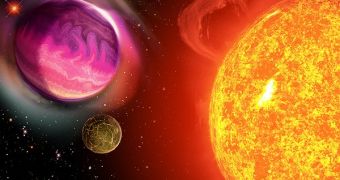Only a few decades ago, astronomers weren't even sure if other solar systems aside ours exist in the universe. Since then, a couple of hundreds of solar systems have been discovered, mostly composed of gas giants. When trying to learn about other solar systems, astronomers often make analogies to our own. If our solar system is so varied, imagine how fascinating other worlds could be. A new study set to start in the fall of this year will make observations on about 11,000 near stars in a period of six years, in the hope we will find at least a few of these worlds.
At first, the number of stars may look overwhelming, but it is, in fact, very small in comparison to the 3,000 stars studied by astronomers to date. The NASA funded project, called Multi-object Apache Point Observatory Radial Velocity Exoplanet Large-area Survey, should find at least 150 new planets.
"We're looking in particular for giant planets like Jupiter. Once we find a big planet around a star, we know that smaller planets could also be there, too," said Jian Ge from the University of Florida, principal investigator for MARVELS. Additionally to finding other new planets, MARVELS would also provide with a compelling test for the theories regarding the solar system formation and evolution.
The study will begin by surveying up to 60 stars at one time, and will eventually reach double that number once the project advances. The 2.5 meter mirror from the Apache Point Observatory - which will be used during the study - has a wide field view about 35 times larger than the apparent size of the Moon on the night sky.
Since the study will have as primary objective the discovery of other gas giant planets, the detection method relies on measuring the wobble of the mother stars determined by the gravitational pull of massive planets. Light coming from the star is fed into a light interferometer which is able to detect small changes in the frequency of the star light, by measuring the Doppler shift determined by powerful gravitational field pulling on the star's surface.
Any periodical variations of the frequency would immediately show that indeed a massive planet is orbiting the respective star.
Another possibility would be to study the chemical composition of the respective star. Stars rich in heavy elements such as silicon, oxygen and nickel are more likely to have gas giant planets orbiting around them, since protoplanets can easily form and evolve into gas giants if enough material is present in the planetary disk. MARVELS will either confirm or deny this theory during its six year study.
Alternatively, gas giants could form simply out of disturbances in the planetary disk. If that is the case, than protoplanets are not required in order to determine a gravitational collapse in a particular cloud of dust and gas.
MARVELS could also reveal how often planets draw closer to their star during their evolution or if they would eventually end up in highly eccentric orbits. With such a high number of stars, at least some patterns should rise, even though not too many planets are found.

 14 DAY TRIAL //
14 DAY TRIAL //